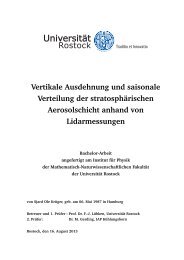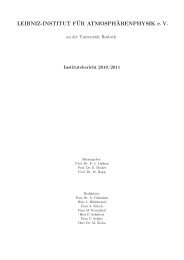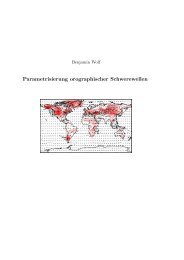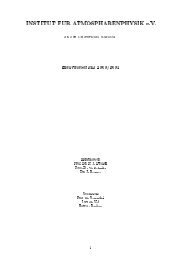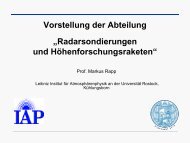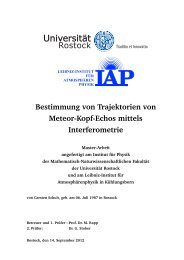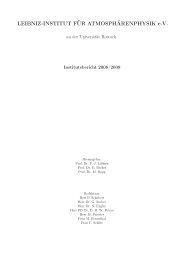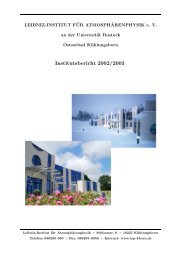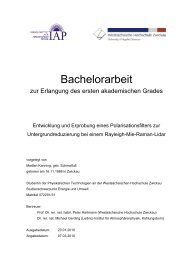Polar mesosphere summer echoes (PMSE): review of ... - HAL
Polar mesosphere summer echoes (PMSE): review of ... - HAL
Polar mesosphere summer echoes (PMSE): review of ... - HAL
Create successful ePaper yourself
Turn your PDF publications into a flip-book with our unique Google optimized e-Paper software.
M. Rapp and F. J. Lübken: Review <strong>of</strong> <strong>PMSE</strong> 2613<br />
Fig. 15. Radar signal to noise ratio (SNR, colored contours) detected<br />
with the ALOMAR SOUSY radar as a function <strong>of</strong> altitude<br />
and time. The black isolines mark the noctilucent cloud detected<br />
by the ALOMAR RMR lidar. This figure is reproduced from<br />
Nussbaumer et al. (1996), copyright by the American Geophysical<br />
Union.<br />
further experimental efforts are needed to obtain quantitative<br />
results on the strength <strong>of</strong> large and small scale electric fields<br />
at <strong>PMSE</strong> altitudes.<br />
2.5 Common volume observations with NLCs<br />
Also common volume observations <strong>of</strong> noctilucent clouds and<br />
<strong>PMSE</strong> confirmed the close relationship between the radar<br />
<strong>echoes</strong> and ice particles in the mesopause region. Nussbaumer<br />
et al. (1996) presented the first common volume observation<br />
<strong>of</strong> a noctilucent cloud with the ALOMAR RMRlidar<br />
and a <strong>PMSE</strong> with the ALOMAR SOUSY radar at the<br />
Andøya Rocket Range (von Zahn et al., 2000; Singer et al.,<br />
1995). As shown in Fig. 15, these authors found a close relationship<br />
between the two phenomena with the NLC layer<br />
located at the lower edge <strong>of</strong> the <strong>PMSE</strong> layer in most <strong>of</strong> the<br />
cases. von Zahn and Bremer (1999) significantly expanded<br />
the data base presented in this first study by analyzing a total<br />
<strong>of</strong> 22 joint NLC/<strong>PMSE</strong> observations and basically confirmed<br />
the close relationship between NLC and <strong>PMSE</strong>. Altogether,<br />
they identified three distinct empirical types <strong>of</strong> <strong>PMSE</strong>/NLC<br />
observations: in the standard case (= type 1; in 66% <strong>of</strong> all<br />
observations), NLC and <strong>PMSE</strong> occurred simultaneously in<br />
the same volume, with the NLC layer located in the lower<br />
part <strong>of</strong> the <strong>PMSE</strong> layer and with identical lower edges. Type<br />
2 allowed for temporal differences between the layers, i.e.,<br />
at times there were NLC present but no <strong>PMSE</strong> (in 16% <strong>of</strong><br />
all observations), and type 3 allowed for spatial differences<br />
between the layers, i.e., at times the NLC was not located<br />
at the lower edge <strong>of</strong> the <strong>PMSE</strong> (in 21% <strong>of</strong> all observations).<br />
The close coupling <strong>of</strong> NLC and <strong>PMSE</strong> is further strong evidence<br />
that ice particles play a substantial role for the creation<br />
<strong>of</strong> the radar <strong>echoes</strong>. In particular, the frequent occurrence <strong>of</strong><br />
type 1 observations leads to the conclusion that NLC are evidence<br />
<strong>of</strong> the particles that have grown large enough to be<br />
visually observable whereas <strong>PMSE</strong> are related to both large<br />
Fig. 16. Upper panel: <strong>PMSE</strong> observed with the EISCAT VHF radar<br />
at Tromsø on 10 July 1999. The lower bar code indicates when the<br />
heater was turned on (blue) and <strong>of</strong>f (white), respectively. This figure<br />
is reproduced from Chilson et al. (2000), copyright by the American<br />
Geophysical Union.<br />
(i.e., when they coincide with NLC) but also the smaller ice<br />
particles that are not yet visually observable. These conclusions<br />
are in line with the standard growth and sedimentation<br />
scenario <strong>of</strong> mesospheric ice particles. In this scenario it is<br />
considered that the ice particles nucleate at the altitude with<br />
largest supersaturation (i.e., close to the mesopause) and then<br />
grow by further condensation <strong>of</strong> water vapor onto their surface.<br />
Then the particles sediment down due to gravity, and<br />
gain further size until they are large enough to be visually<br />
observed as NLC (see also Turco et al., 1982, and Sect. 3.1).<br />
2.6 Active modulation <strong>of</strong> <strong>PMSE</strong>: the heating experiments<br />
Recently, Chilson et al. (2000) have opened a new experimental<br />
‘window’ for the study <strong>of</strong> <strong>PMSE</strong>: these authors used<br />
a powerful HF heater in order to modify the electron temperature<br />
at altitudes where <strong>PMSE</strong> was simultaneously observed<br />
with the EISCAT VHF radar to temperatures <strong>of</strong> ∼3000 K<br />
(Belova et al., 2001). Stunningly, the <strong>PMSE</strong> immediately<br />
disappeared when the electron gas was heated and immediately<br />
reappeared when the heater was switched <strong>of</strong>f (see<br />
Fig. 16).<br />
While Chilson et al. (2000) used a rather short cycling <strong>of</strong><br />
heater ‘on’ and ‘<strong>of</strong>f’ phases, Havnes et al. (2003) applied a<br />
different heating sequence with a short heating period followed<br />
by a long heater ‘<strong>of</strong>f’ phase. As shown in Fig. 17,<br />
these authors observed a strengthening <strong>of</strong> the <strong>PMSE</strong> after the<br />
www.atmos-chem-phys.org/acp/4/2601/ Atmos. Chem. Phys., 4, 2601–2633, 2004



